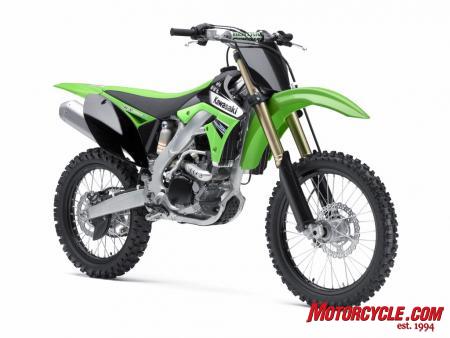2011 Kawasaki KX250F Review - First Impressions - Motorcycle.com
Get the Flash Player to see this player.
Motorcycle.com was fortunate to be invited to the North American press launch of the new bike at famous Budd’s Creek, with ‘fast guy’ Greg Jones (the son of three-time U.S National MX Champion Gary Jones) providing ‘fast guy’ input.
On the tech side, the big news is the Kehin battery-less fuel injection system. It is the same basic system used on last year’s KX450F but with different calibration; the high-rpm nature of the 250F requires 20 percent more fuel flow than the 450 does! The ECU is infinitely adjustable with software from Kawasaki, but the bike comes stock with six preset fuel and ignition maps to allow most riders to tailor the powerband to their liking.
The Kehin EFI system relies on input from a gear position sensor, an air pressure sensor, a water temperature sensor and an air pressure sensor to optimize the air/fuel ratio. The system also incorporates a ‘vehicle down’ sensor, designed to shut the engine down if you crash. Kawasaki’s goal was to improve throttle response and smooth out the powerband without losing power over the carbureted model, which it did; the engine makes slightly more mid to top-end power than the 2010 model.
Along with fuel injection the engine features new camshafts and valve springs, a new piston, a new cylinder, a new crankshaft, revised gear ratios and a new easier shifting gear shift mechanism. The air intake volume and the headpipe length were increased to improve low-rpm response, and the quieter new muffler is designed to meet 94 dbA.
The Separate Function Fork (SFF) system is preload adjustable, as well as for compression and rebound. Advantages include a 1.5-pound weight reduction, less stiction, and less expensive servicing than conventional motocross forks.
The offset of the new tripleclamps has been reduced to 22.5 mm to give the bike a lighter handling feel and increased front wheel traction. The rear shock also got the slippery Kashima treatment, along with new settings to better match the new fork up front. This sounds weird, but the engine mounts were changed from stiff aluminum to more flexible steel. Kawasaki’s factory riders claim this resulted in lighter handling, better cornering and better overall maneuverability. The saddle has a new cover with increased side grip, and the 232.7 pound bike sells for an MSRP of $7,299.
So what’s it like to ride? Budd’s Creek was beautifully prepped for the product launch, so Jones was Jonesing to ride the new KX250F. We also eavesdropped on what the other invited riders had to say about the new bike, so we can make some pretty solid first impression notes.
Engine-wise, the 2011 has slightly stronger power than the 2010 model overall. It’s a revver, but makes loads of torque at all points of the powerband. Throttle response was instant and perfect, even on our very humid 97-degree ride day. No matter how hard you slammed into obstacles the bike never hiccupped or popped like the carburetor bikes were prone to doing. The new transmission also shifts well under power and the revised clutch has a great feel and light pull. In the rare case the bike did fall below the powerband a little tickle of the clutch lever was enough to get it singing again. So our initial worries about fuel injection hurting the great performing 2010 model have been put to rest!
Starting took three kicks, almost always. Hot, cold, whatever, three kicks and it was lit. The new muffler is very quiet at idle and just above, but unfortunately still has that raspy sounding bark at WOT that Kawasaki’s are infamous for. As the test wore on the bikes became noticeably louder as well, so muffler packing service life is somewhat suspect.
"No matter how hard you slammed into obstacles the bike never hiccupped or popped like the carburetor bikes were prone to doing."
Nearly every rider at the press launch fiddled with the fork under the guidance of a technician from Showa. Jones finally settled on 1/2mm less preload and two-clicks less compression than stock settings and was very happy with the performance at Budd’s Creek. The rear suspension sag was set at 102mm and drew zero complaints.
Ergonomics, like last year’s bike, are a little thick but comfortable. The 7/8” Renthal bars seem a little old-fashioned, but are comfortable and strong. The new seat is comfortable, but the riders started to wear off the rather plain looking tank decals within an hour of riding. The relationship between the bars, saddle and footpegs was spot-on for the average 5’10 rider, and while not the lightest bike in the class the 2011 KX250F does feel lighter than the old version.
After our first date with the 2011 KX250F we were quite impressed. Kawasaki has taken great strides in addressing the issues we had with last year’s bike, along with great improvements in engine management thanks to the new EFI system. We can’t wait to get our hands on a KX250F for a full test later this season!
Related Reading
2010 Kawasaki KX250F Review
2010 Kawasaki KX450F Review
2010 Kawasaki KLX110 & KLX110L Review
All Things Kawasaki on Motorcycle.com
More by Dan Paris


































Comments
Join the conversation